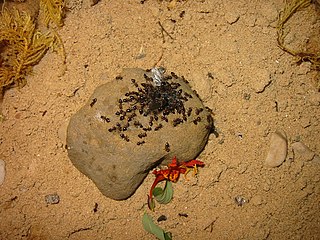Crematogaster atitlanica is a species of ant endemic to Guatemala .

Crematogaster is an ecologically diverse genus of ants found worldwide, which are characterised by a distinctive heart-shaped gaster (abdomen), which gives them one of their common names, the Saint Valentine ant. Members of this genus are also known as cocktail ants because of their habit of raising their abdomens when alarmed. Most species are arboreal. These ants are sometimes known as acrobat ants.

Crematogaster pilosa species of ant in the subfamily Myrmicinae. It is native along the southern Atlantic coast of the United States and some interior areas. These polydomous ants have been found living in tidal marshes, wet meadows and other environments in plant stems, logs, and fallen branches.

Crematogaster ashmeadi, commonly known as the acrobat ant, is an arboreal ant widespread in the Southeastern United States. It nests and forages almost exclusively above ground level, often found in treetops and on lianas. It is one of eleven species in the genus Crematogaster that is native to eastern North America. This ant species has been observed to raid wasp nests, including the species Mischocyttarus mexicanus, and to forage on their brood. It is the most dominant arboreal ant in the pine forests of the coastal plains of northern Florida. Colonies of these ants inhabit a majority of pine trees in the area, living in chambers in the outer bark of living trees that have been abandoned by bark-mining caterpillars, usually of the family Cossidae. C. ashmeadi does little to no excavation of its own, relying solely on chambers bored out by other insects.
Crematogaster gordani species of ant in the subfamily Myrmicinae.
Crematogaster montenigrinus species of ant in the subfamily Myrmicinae.

Crematogaster peringueyi is a southern African arboreal species of ant. They are commonly known as the black cocktail ant or swartwipgatmier (Afrikaans) for their colour and habit of arching their tails when alarmed.
Crematogaster cerasi is a species of ant in tribe Crematogastrini. It was described by Asa Fitch in 1855.
Crematogaster dohrni, is a species of ant of the subfamily Myrmicinae, which is a widespread species that can be found from Sri Lanka, India, Indonesia, Thailand, and China.
Crematogaster consternens is a species of ant of the subfamily Myrmicinae, which can be found from Sri Lanka.
Crematogaster pellens is a species of ant of the subfamily Myrmicinae. It can be found from Sri Lanka.
Crematogaster ransonneti is a species of ant of the subfamily Myrmicinae. It can be found in Sri Lanka and India.
Crematogaster rogeri is a species of ant of the subfamily Myrmicinae. It can be found from Sri Lanka.

Crematogaster rogenhoferi, is a species of ant of the subfamily Myrmicinae, which can be found from Sri Lanka.
Crematogaster rothneyi, is a species of ant of the subfamily Myrmicinae.

Crematogaster torosa is a species of ant in the family Formicidae.

Crematogaster laeviuscula, known generally as the acrobat ant or valentine ant, is a species of ant in the family Formicidae.

Crematogaster hespera is a species of ant in the family Formicidae.







